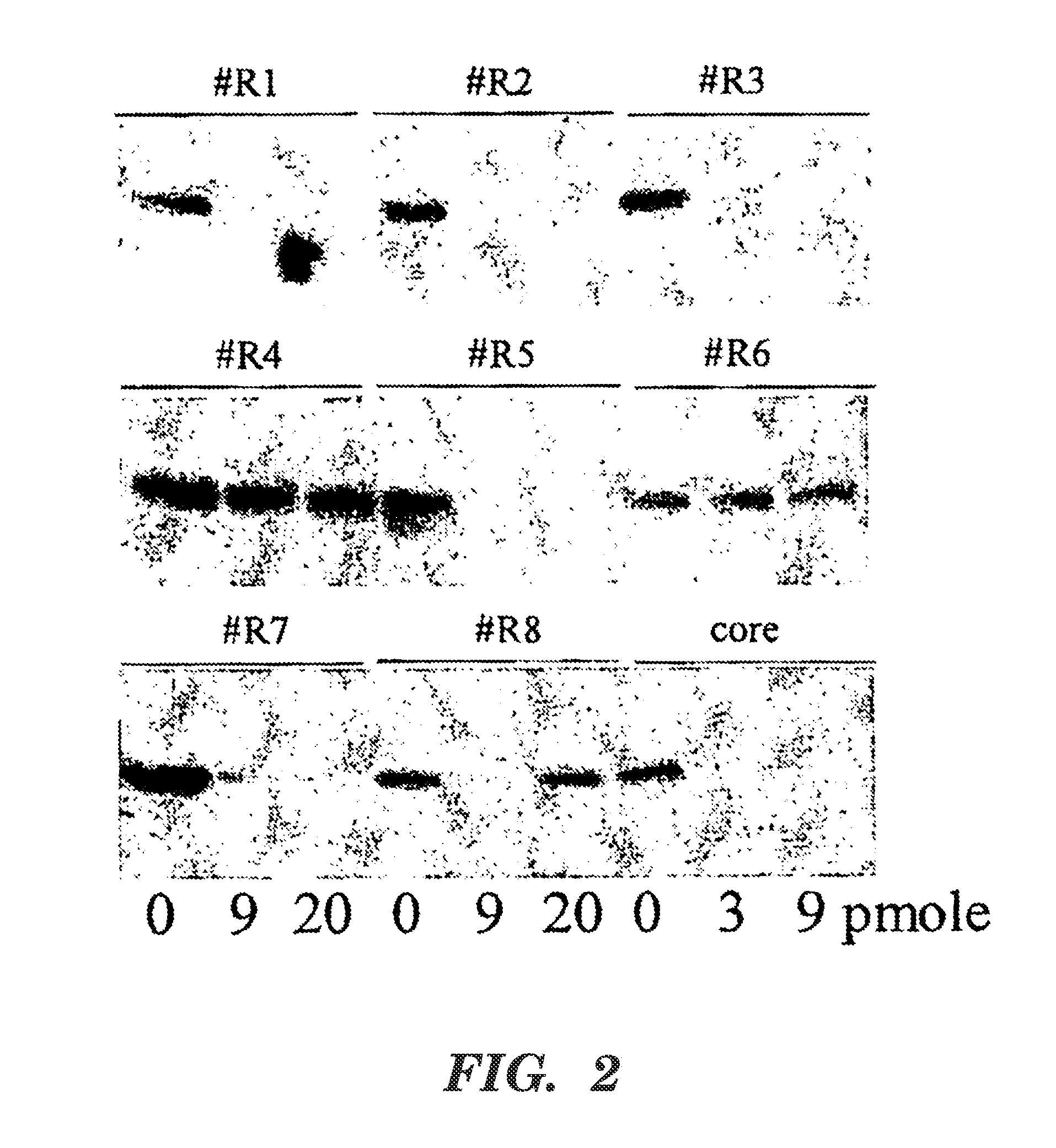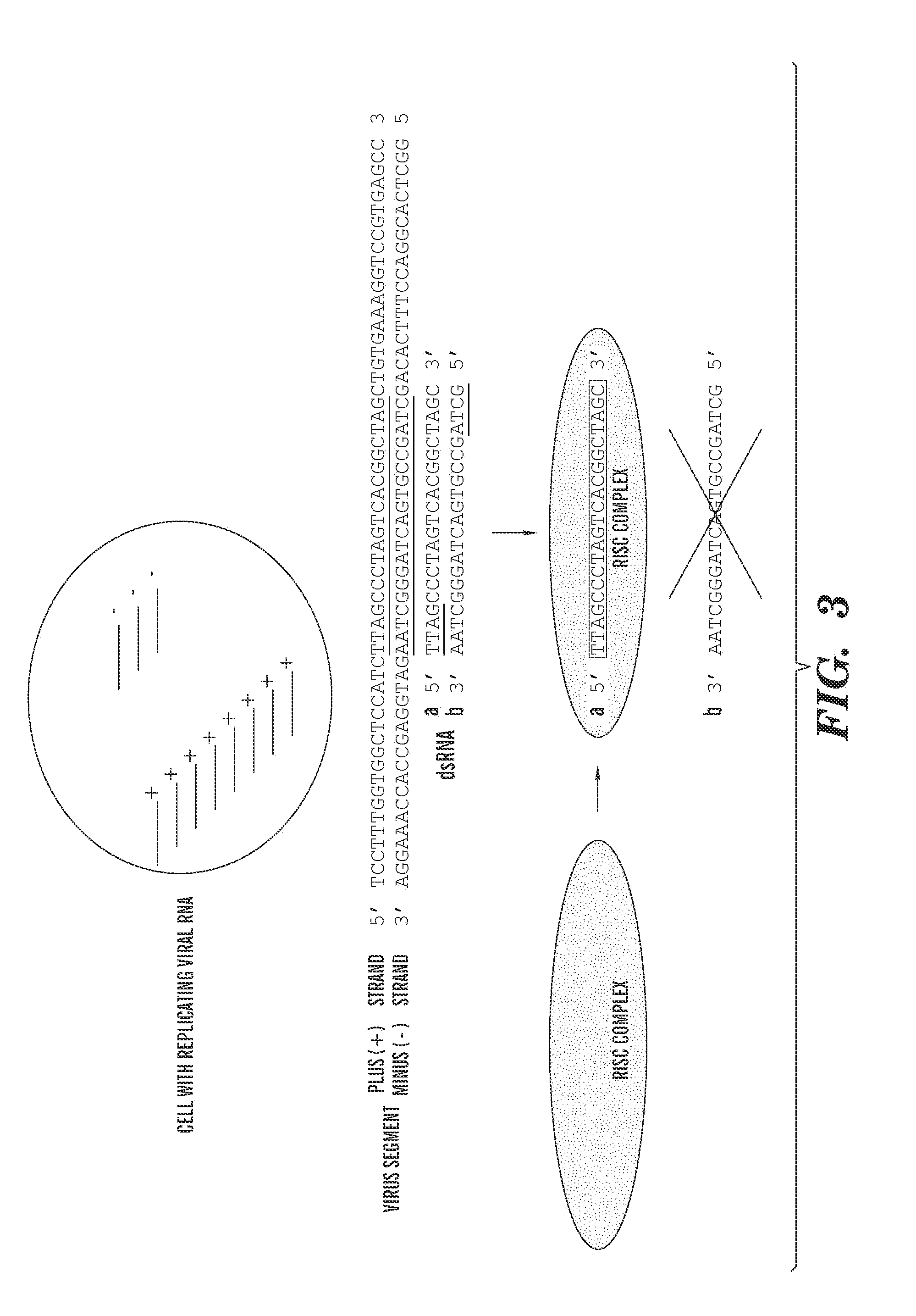Targeting opposite strand replication intermediates of single-stranded viruses by rnai
a technology of opposite strands and replication intermediates, which is applied in the direction of biochemistry apparatus and processes, organic active ingredients, drug compositions, etc., can solve the problems of nucleic acid applicability, interference with the translation of mrna into protein, and the method of targeting e.g. minus-strand rna in preference to its complementary viral mrna has not been demonstrated, so as to achieve low thermal stability
- Summary
- Abstract
- Description
- Claims
- Application Information
AI Technical Summary
Benefits of technology
Problems solved by technology
Method used
Image
Examples
example 1
Plus Strand Targeting
[0083]Brief introduction: The hepatitis C virus (HCV) is the primary cause of non-A, non-B transfusion-associated hepatitis and accounts for more than 200 million hepatitis cases worldwide. The HCV genome has a high degree of sequence variability. There are six major genotypes comprising more than fifty subtypes and significant heterogeneity hallmarked by quasi-species has been found within patients. Great progress in understanding HCV replication has been made by using recombinant polymerases or cell-based subgenomic replicon systems. By using the replicon cell system, siRNA has been demonstrated to be able to suppress HCV protein expression and RNA replication. Sequences of the 5′ NTR and both structural and nonstructural genes have been targeted successfully. U.S. Pat. No. 5,874,565, “Nucleic Acids Comprising a Highly Conserved Novel 3′ Terminal Sequence Element of the Hepatitis C Virus”, teaches a highly conserved 101 nt sequence believed to be important in ...
example 2
Minus Strand Targeting
[0088]Example 2 was performed as described in Example 1 except that siRNAs R1-R8 were used in transfections. The Western Blot assay performed here was as described in Example 1. The control HCV core siRNA used as a positive control is the siRNA described in the previous HCV Example 1. All siRNAs evaluated map to the 3′ UTR of the HCV genome and are conserved amongst HCV genotypes and quasi-species.
[0089]FIG. 2 is a Western Blot showing levels of HCV NS5A protein at (left to right) 0, 9, and 20 pmole of the identified siRNA, and 0, 3, and 9 pmole of the core positive control siRNA. siRNAs R1 (SEQ ID NO:23), R2 (SEQ ID NO:22), R3 (SEQ ID NO:21), R5 (SEQ ID NO:19), and R7 (SEQ ID NO:17) all exhibited significant inhibition of HCV. Additionally, siRNA of SEQ ID NO:11, SEQ ID NO:12, SEQ ID NO:13, SEQ ID NO:14, and SEQ ID NO:15 also were effective at specifically targeting the minus strand (data not shown). Table 2 lists the sequences of the siRNAs used in Example 2....
example 3
DNA Plasmid Vector Expressing 4 shRNAs Targeting the Negative Strand of HCV
[0090]In this example, the siRNA sequences given as R1, R2, R5, and R7 in FIG. 2 are generated intracellularly by expression from a plasmid vector transfected into the cell; the vector is made by cloning oligonucleotides encoding the four short hairpin (shRNA) forms of the siRNAs each under the control of a different RNA polymerase III promoter in a single vector (i.e., four RNA polymerase III promoters each operably linked to a sequence encoding one of the four shRNAs). In these shRNA trancripts, the Effector Strand is joined to the Effector Complement strand via a 9 base “loop” sequence (AGAGAACUU).
[0091]Using standard recombinant DNA techniques, a plasmid containing a bacterial antibiotic selection marker and origin of replication is selected as the starting point for the insertion of the specific promoter / shRNA combinations below. The plasmid is made by first combining an approximately 1 kb fragment (cont...
PUM
| Property | Measurement | Unit |
|---|---|---|
| thermal melting point | aaaaa | aaaaa |
| thermal melting point | aaaaa | aaaaa |
| temperature | aaaaa | aaaaa |
Abstract
Description
Claims
Application Information
 Login to View More
Login to View More - R&D
- Intellectual Property
- Life Sciences
- Materials
- Tech Scout
- Unparalleled Data Quality
- Higher Quality Content
- 60% Fewer Hallucinations
Browse by: Latest US Patents, China's latest patents, Technical Efficacy Thesaurus, Application Domain, Technology Topic, Popular Technical Reports.
© 2025 PatSnap. All rights reserved.Legal|Privacy policy|Modern Slavery Act Transparency Statement|Sitemap|About US| Contact US: help@patsnap.com



